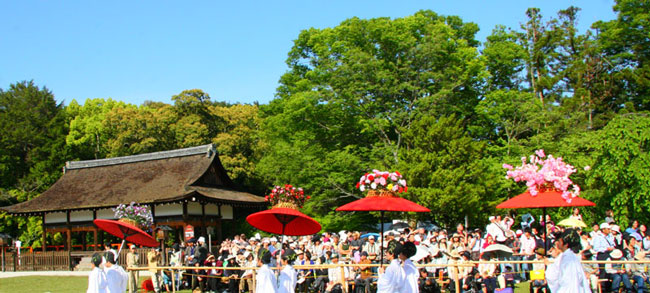
Everyone in Japan has a favorite season to visit Kyoto -- the blazing foliage of Autumn and the Sakura of Springtime are justifiably popular. But if you can manage to be in Kyoto in the middle of May, you'll be treated to a colourful 1400-year-old festival.
Always held on May 15 every year (ie. easy to plan your trip around it), the Aoi Matsuri is by far the most ancient, if not the most visually striking, of the "Big Three" annual festivals of Kyoto (the other two being the Gion Matsuri in August and the Jidai Matsuri in October). Just how old? The Tales of Genji has a chapter where two of Genji's lovers had a fight at the Aoi Matsuri -- and it was written 1000 years ago.
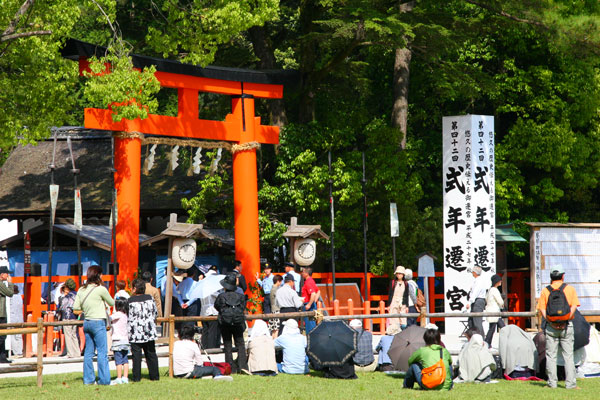
To this date, the participants of the festival still dress in Imperial Court attire from the Heian Period (8th to 12th Century AD). In contrast to the rowdy Gion Matsuri of the peasantry, the Aoi Matsuri is almost a religious procession for the aristocracy and is really more of a spectator event than something you partake in. A 700-metre-long line of archers, horsemen, ox carts and young ladies dressed in exquisite gowns would walk the entire 8 kilometres of city streets from the old Imperial Palace to the Kamigamo Jinja shrine in north Kyoto. If you thought your jeans and camera gear are heavy and uncomfortable in Kyoto's humid summer, you should be glad you're not wearing a 30-kilogram ceremonial gown in 12 layers (as we will see below).
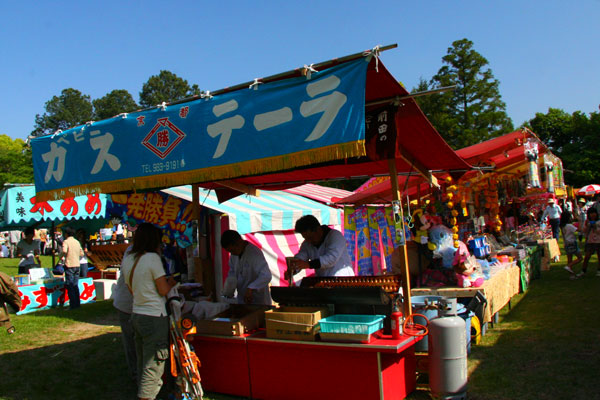
Of course, no Japanese festival is complete without a temporary town of Yatai, or mobile food stalls selling anything from Takoyaki balls to iced lemonade to mini games with Hello Kitty prizes. The blue stall in the foreground sells "Baby Castella" sponge cakes, and we bought a little bag for 300 yen -- not bad, not great -- just what you'd expect from a Yatai.
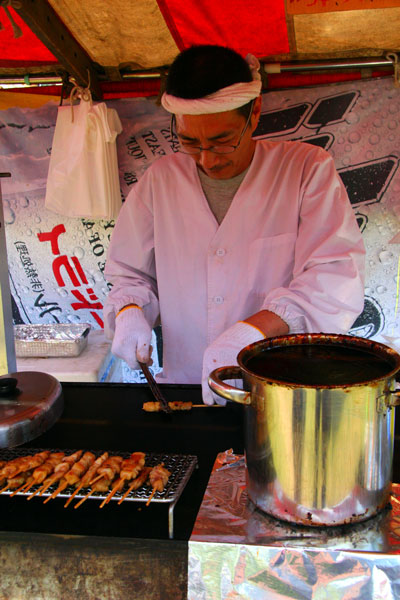
As always my favorite is the simple Yakitori skewer. The big metal pot is the barbecue sauce, but I'm purist when it comes to Kushiyaki food and I usually ask for salt flavor. On this day all we had for lunch was Yakitori, Castella, and a hotdog. We could have gone to a restaurant but hey, why miss the complete festival experience?

We made it to the Kamigamo Jinja shrine around 14:45 to grab a snack and find a good viewing spot, but it wasn't until around 15:30 when the head of the procession started to arrive. Here a Furyukasa (decorated umbrella) led a delegation of officials on the path towards the inner shrine.
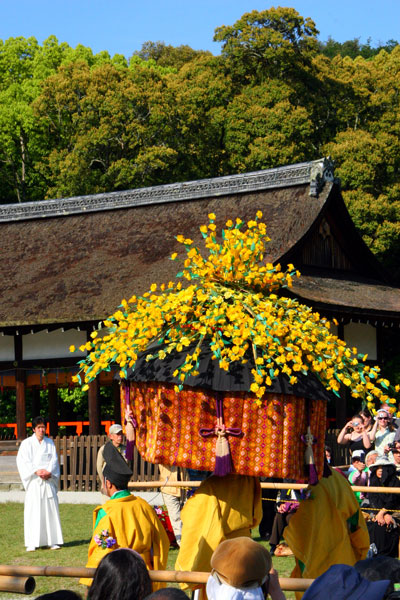
The festival's proper name is actually Kamo Matsuri, named after the guardian deity worshipped by the two host shrines -- Kamigamo Jinja and Shimogamo Jinja. The popular name of Aoi Matsuri was coined for the Aoi (hollyhock) flowers used in the decoration of the procession.
Leading to the main event on May 15 are other peripheral ceremonies, the most well-known being the cleansing of the hands of the Imperial Court ladies at one of the two shrines on May 4, and a photogenic display of horseback archery which I've seen only on TV. All very famous stuff, in case you happen to be in Kyoto during the two weeks leading up to the main festival.

To this day the festival still features a Messenger (Chokushi) from the Imperial Court in Tokyo whose primary objective is to visit each of the two shrines and deliver a prayer on behalf of the Emperor, then present gifts from the Imperial family which would always include a horse of exceptional pedigree. These horses would been seen later at the festival's dramatic finale at the end of the day.

In the past a whole regiment of servants would accompany the Imperial Messenger, but in the modern era commoners are dressed in old Imperial Court attire to carry on the grandeur of the ancient festival. This includes a representation of provincial governors and their bow-and-arrow-bearing bodyguards, various officials in the old Imperial Court, load-bearers carrying a wooden chest of religious offerings from the Emperor, dancers, musicians, firemen and other peasant followers.
The beautifully symmetrical Japanese umbrelllas was only an introduction to the grand entrance of the central character of the festival, the rightful focus of the parade...

The Saio-dai, a young maiden chosen to represent the role of the Imperial Princess of the Heian Period as the figurative head of the two shrines. This year's Saio-dai was 25-year-old Murata Shiho, future successor to the famed Ryotei restaurant Kiku-no-i (http://www.kikunoi.jp/).
Befitting the regal status of the Saio-dai, the traditional Juni-hitoe (12-layer gown) was said to weigh an exhausting 30 kg, cost 5.5 Million yen (CAD$55000) and took two kimono-dressers three hours to put it on her. If you're wondering how the fortunate young lady managed to walk 8 km under all this suffocating weight and heat, the answer is she didn't -- she sat inside a wheeled palanquin pulled by her servant followers for most of the way.
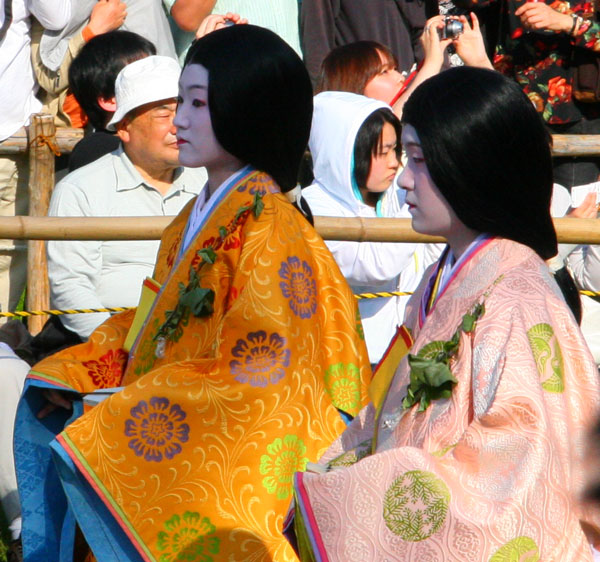
You won't likely see it unless you somehow catch the Saio-dai sneezing, but she's supposed to be wearing a metallic black glaze (Ohaguro) on her teeth. Following the Saio-dai were the representation of lesser female officials known as Myobu, dressed in superbly handwoven Kochiki robes worthy of heirloom status in most middle-class families. This is getting very expensive as annual festivals go.

Everyone representing the female officials were dressed in formal court attire of appropriate of the 9th Century, complete with a whole detachment of servant followers and musicians.
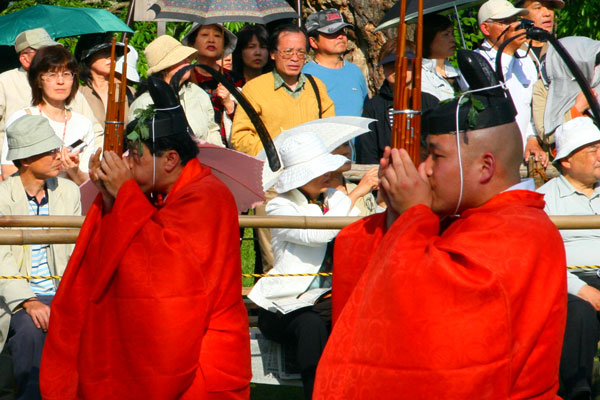
Musicians playing an ancient bamboo instrument known as the Sho. Introduced from continental Asia back in the 7th Century, it is one of the instruments that would likely have been performed at the festival's inauguration more than a millenium ago.
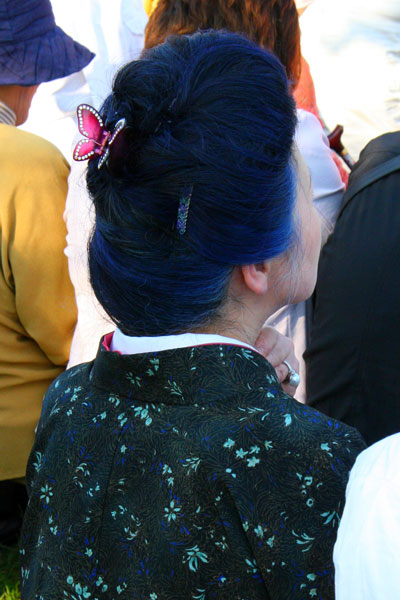
The festival grounds was also a good place for people-watching as the ladies all came out with their latest Kimonos and boldest hairstyles for the celebrations. Even the grandmothers.
Soon after the appearance of the Saio-dai the parade came to an unexpected and abrupt close. Some got up and left but most stayed behind waiting for something, but at the time we didn't know what we were waiting for.

So we were standing behind the paying section when the middle aged lady beside us started to strike a conversation. It turned out to be her first time watching the Aoi Matsuri as well, and she ALSO was wondering where the rest of the procession had gone. K-san was a 50-ish-year-old woman from nearby Kobe, just a 90-minute train ride from Kyoto, and just as expected she was rather surprised that we had traveled from as far as Vancouver. Being a gracious host, she scurried around to gather more information, and came back with a simple answer -- the horses were tired from a full day's work and needed a little more rest.
K-san then did something entirely uncharacteristic of the Japanese -- a civic disobedience I would never expect from a Japanese housewife -- she sat down at the paying section and invited us to sit down with her, all directly under the watchful eyes of festival staffs whose primary job was to prevent unlawful entry to the paying section! We did sit down with her for a little while out of politeness, and then left for another (standing) spot closer to the entrance of the shrine. If I absolutely wanted a seat I would have paid for it ... but it's just not worth the 2000 yen.
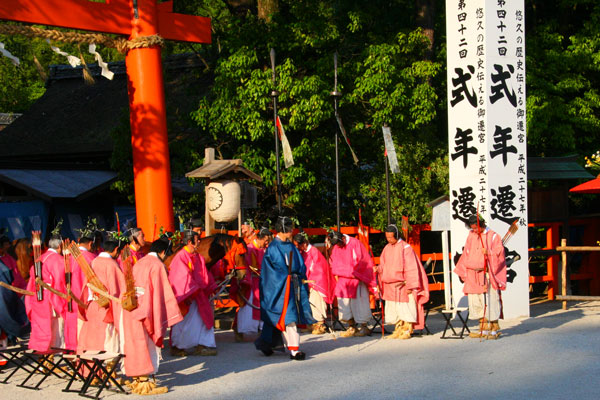
A horse! Finally. This was the beginning of the end of today's festivities, when the officials started to bring the horses and riders into the shrine for the grand finale known as Soume, or Running of the Horses.

Remember the horse bestowed by the Emperor as a gift to the shrine? Well this is it. First all the horses were led into the shrine to receive some sort of purification and blessing.

A very fine horse, as you can see from the shine on its coat. It would be majestic enough even without all this meticulous decoration.

The horses were led back to the first Torii gate. The Soume ritual would involve six horses and their riders in full regalia, galloping down the 500m course between first and the second Torii in full speed.

And full speed it was! You have to see it live as the riders blew by in such a blur.

Uaaaaaaaaaaaah!!! this rider screamed at the top of his lungs, like a samurai riding into battle. Of course all the audience knew it's for show so there's a somewhat comical quality to it. By now the long wait was all but forgotten and everyone was laughing and having a good time.
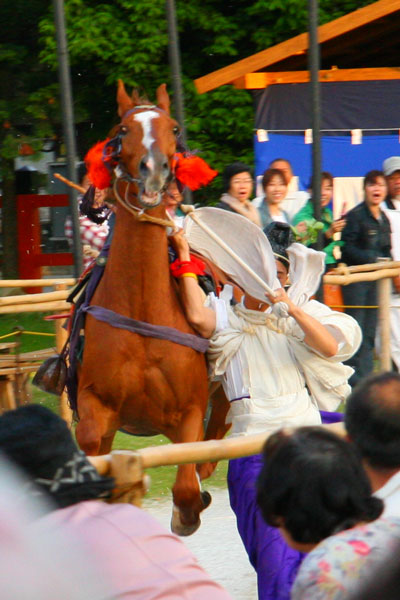
And then the real comedy happened. Actually it wasn't that funny at first, when everyone watched in horror as the very last horse threw the rider off its back! But even more amazing was how the determined rider managed to hold on to the reins, land on his feet, and run with the horse on the ground to slow it down.

Gambatte ne!! the specators applauded the rider's effort to control the horse and prevent it from galloping wild into the stands. Oh well, at least five of the six horses had finished the final ritual, and the crowd was ready to go home happy.
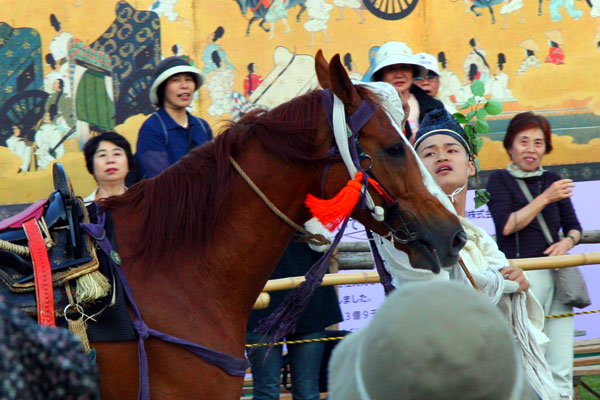
But wait ... why was the rider dragging the horse back to the starting line? Now the entire shrine was buzzing and everyone got nervous about this stubborn rider with his stubborn horse. Carrying out the completeness of the ritual is one thing, but endangering one's own life is something else.
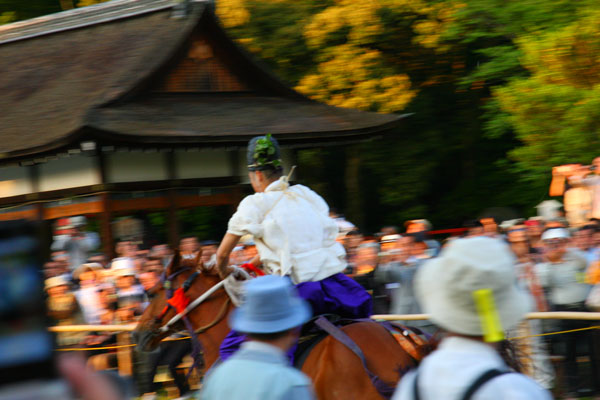
Well, the horse got the message this time. In full obedience it streaked down the course at scorching speed, taking itself and its master towards the second Torii amidst a full standing ovation of applause. In fact it raced past the finish line in full gallop and didn't even slow down until a couple hundred metres after the Torii. A dramatic finale to the day's events, and now everyone could go back with a good story for the family.
PRACTICAL INFO
The head of the procession starts from the Imperial Palace at 10:30 AM, arrives at Shimogamo Jinja around 11:40, leaves the Shimogamo Jinja again at 14:20 PM, then finally arrives at the Kamigamo Jinja around 15:30 PM. Note that this is the scheduled times for the HEAD of the line, and it takes almost an hour for the entire procession to pass through. So if you just want to take a 10 minute glimpse, you can in fact take advantage of the 1-hour window and just see some random parts of it. But if you think this may be the only chance in your lifetime to see a Japanese festival and you don't want to miss anything, then it's probably best to view it under the backdrop of one of the three excellent host venues.
Where are the venues geographically and where does the festival route pass through? I couldn't find an English map on the web so I made one myself, courtesy of the good info from the Kyoto Shimbun newspaper:
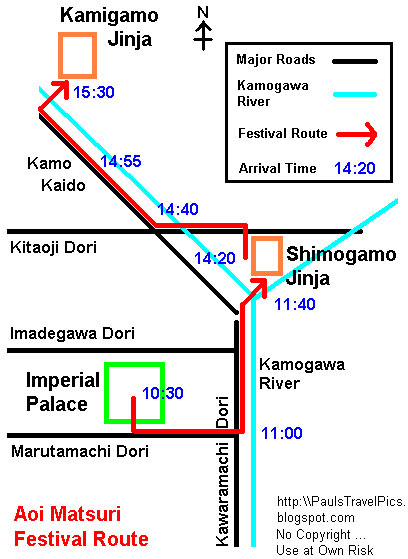
As you can see, the Imperial Palace is at the south, which you can easily reach by subway's Marutamachi Station. But if you want to take advantage of the excellent City Bus Daypass for 500 yen (available at major subway stations and onboard some buses), Bus 205 will take you from the Kyoto Station to the East side of the Imperial Palace. Get there before 10:30 if this is your choice of venue. After the procession leaves, you'll have time to wander the huge palace grounds.
Another possibility is the Shimogamo Jinja shrine (a UNESCO World Heritage Site), also served by Bus 205 but has no subway station. You could plan on arriving around 11:40 and see the procession before lunchtime, or you could arrive around 14:20 and watch them heading out to the streets of Kyoto again. This option may give you a bit more flexibility.
But if you're arriving too late for the morning procession like we did, you'll have no choice but to head for the Kamigamo Jinja (another UNESCO World Heritage Site). This is the least convenient venue by public transportation, as there is no subway station and is served only by City Bus 4, 46, and 67. Bus 4 and 67 serve the northeastern and western suburbs and doesn't really do much for most tourists, but Bus 46 starts from the tourist district of Gion, passes by the Nijou Station where you may transfer from JR or subway, and ends up at Kamigamo Jinja on its final stop. So this is still easily manageable if you can plan your sightseeing around the City Bus routes. Arrive around 15:30 and plan on spending the rest of the afternoon there -- in 2008 they didn't start the Running of the Horses until 17:45.
You can download the route maps of the City Bus and Subway from the City of Kyoto.
Finally, although the Aoi Matsuri is always scheduled for May 15 every year, if the weather turns really ugly they will postpone the processions by one day, as it did happen a couple of times in the past decade. Just plan your stay in Kyoto for at least two or three days -- in fact my opinion is that you can't really see Kyoto's major sights without at least 3 days, and only if you keep busy with your sightseeing.
Tidak ada komentar:
Posting Komentar